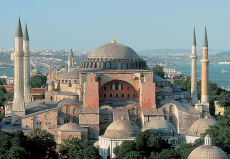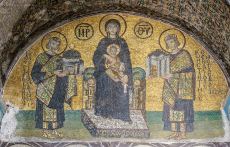
Hagia Sophia in Istanbul is a former Greek Orthodox cathedral, later a mosque, and is now the second most visited museum in Turkey. Considered an architectural marvel since its construction in 537, it has even been called the Eighth Wonder of the World, and is now a UNESCO World Heritage Site. This magnificent building is even more interesting as it embodies the turbulent history of Istanbul.
The city was founded as Byzantium around 660 BCE. In 330, it was chosen as the capital of the eastern part of the Roman Empire, which came to be known as the Byzantine Empire, by emperor Constantine the Great. Constantine was also the first Roman emperor to publicly convert to Christianity, and celebrated by commissioning a huge church in his new capital, Constantinople. Known as the “Great Church,” it was burnt down in 404. Unfortunately the replacement church, which was completed in 415, was again burnt down in the Nika Riots of 532. This was a revolt against the Emperor Justinian I, caused by political and social issues such as high taxes, but inflamed by a group of chariot race supporters being charged for murder. The riots destroyed much of the city, and seriously threatened Justinian’s rule.
Justinian was a very ambitious emperor. He wanted to recapture the western part of the Roman Empire, which had fallen to Gothic tribes from the end of the 4th century. Following the Nika Riots he had even more reason to assert his power. The construction of a new and even larger basilica was announced only a month after Justinian had successful stopped the riots, and the architect Isidore of Miletus was hired for the job.
Materials for the new church were brought from all over the empire: green marble from Thessaly, part of modern Greece; yellow stone from Syria; and black stone from the Bosphorus region beside Constantinople. Columns were salvaged from the Temple of Artemis, in central Turkey, which had been destroyed by Goths in 401. Huge slabs of porphyry were shipped from Egypt, especially priced as their purple-red was the colour of royalty. Together more than ten thousand men were employed to build the huge structure, and it took them nearly six years to do it. When the church was inaugurated in December 537, it was the largest church in the world, and remained so for the next thousand years. It was dedicated to the Wisdom of God, and so called the Hagia Sophia, the Greek for Holy Wisdom.
Most remarkable about the Hagia Sophia was, and is, its huge central dome. Unfortunately due to its great weight it was damaged by many earthquakes, and completely collapsed in 558. In 562 Isidore the Younger, nephew of the original architect, designed a new dome from lighter materials and made it seven metres taller, bringing it to 55.6m high. A new inauguration was held, and Justinian’s official poet Paul the Silentiary was commissioned to write an epic 1029 verse poem about the church.

Another notable feature of the church is its many mosaics, which were added throughout the centuries. Many of the original mosaics were destroyed during the reign of Leo the Isaurian in the 8th century as an act of iconoclasm, which means that religious images were opposed by the church. Mosaics from the 9th centuries onwards still survive, and depict religious figures and various emperors, as well as geometric patterns. A mosaic (pictured) above the southwestern entrance shows the Virgin Mary seated with Jesus. To her left is the emperor Constantine, presenting a model of the city, while to the right Justinian presents a model of the Hagia Sophia.
This, with all the other mosaics, was covered in plaster when the church became a mosque. The city of Constantinople, and with it the Byzantine Empire, fell to the Ottoman Empire in 1453. Sultan Mehmet II allowed his troops to loot the building, and then declared that it would be renovated and converted into Aya Sofya, the first imperial mosque of the newly renamed city of Kostantiniyye. The minarets, the tall spires at the corners of the building, were added from 1481. These are used for the call to prayer. A mihrab was added in place of the altar, and is a niche in the wall pointing towards Mecca. The Ottomans were also responsible for important renovation work on the increasingly ancient church.
The most famous of these renovations was ordered by the Sultan Abdülmecid in 1847. He hired the Fossatis, two brothers from Switzerland, who spent two years and used 800 workers to completely renovate the mosque. Probably the most noticeable addition was the huge 8 metre circular plates which were hung on the central columns of the building. A famous calligrapher, Kadıasker Mustafa İzzet Efendi, was hired to inscribe the names of Allah, Muhammad, the first four caliphs and the two grand children of Muhammad in golden gilt on the large disks.
In 1935 the first President of the Turkish Republic, Mustafa Kemal Atatürk, transformed the building into a museum. This was part of his efforts to modernise the country and make it more secular (not officially connected with religion). It was also during this time that Istanbul became the official name of the city. The white plaster was removed from the mosaics, and the carpet which covered the floor for Muslim prayers was also removed. This uncovered the Omphalion, a series of marble circles on the floor which marked the spot where Byzantine coronations took place. Restorations continue on Hagia Sophia, which is threatened by damp and structural instability. In recent years there have been calls by various groups to reconvert the building into a church, or into a mosque, or even both, but in the meantime millions of people continue to visit it each year. One of Istanbul’s many stray cats, named Gli, has taken up residence museum, and even has his own Tumblr page.
Images: http://1.bp.blogspot.com/-M-WA206O7xE/UaiN4Hn_dbI/AAAAAAAAFkw/VrYK8l6IsyU/s1600/hagia_sophia.jpg
https://upload.wikimedia.org/wikipedia/commons/thumb/e/e9/Hagia_Sophia_Southwestern_entrance_mosaics_2.jpg/800px-Hagia_Sophia_Southwestern_entrance_mosaics_2.jpg

0 Comment:
Be the first one to comment on this article.